Digital Food Safety System
Save time, reduce hassle and keep your business inspection-ready.
What is a gas emergency?
All of these are considered a state of emergency.
LPG is safe, right?
But first why do we always talk about this kind of stuff? LPG is safe right? Isn’t this just scaremongering or getting people to pay for measures they probably won’t ever need?!
Well, 2025 has been a busy year for gas safety! Since the start of the year NCASS has been made aware of numerous gas incidents that have ranged from whole units being decimated by a gas explosion and serious injuries, to third degree burns.
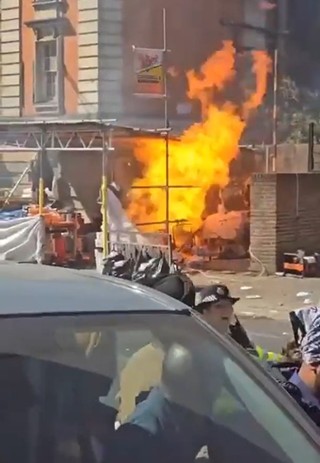
An LPG cylinder caught fire in a food stall in Southall, London in April 2025, injuring several people and closing a public event.
These incidents have been caused by poor installations. For example, poorly maintained or even broken appliances. As well as a lack of LPG safety training and equipment misuse.
Liquefied Petroleum Gas (LPG) is used widely by the mobile catering and street food sector and is fundamentally a safe product if used and maintained correctly. LPG is safe when it is confined to the cylinder or supply pipework. It is what we do with the gas supply and how we interact with it that can make it unsafe.
We must not get complacent of the risks and must always apply the essential safety rules. Which is why as part of national Gas Safety Week we wanted to remind everyone of the risks, how to respond safely in the event of an emergency, and the key things to be aware of when using LPG.
What are the risks?
Risks include gas leaks, fires or flames where they shouldn’t be, the build-up of unburnt gas that could cause explosions, or appliances burning gas incorrectly causing Carbon Monoxide (CO) poisoning.
Examples of gas leaks
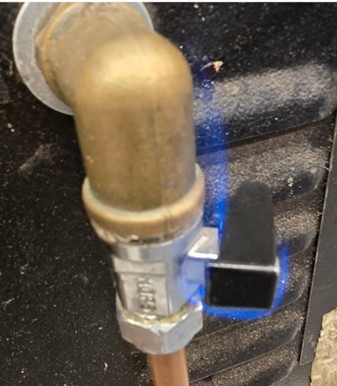
A gas leak where the accumulated gas has managed to catch fire as denoted by the blue vapour.

Leak detection fluid used to detect a leak – evidence of a small leak between the supply hose and a generator, denoted by the appearance of bubbles. Remember “Bubbles is troubles”.
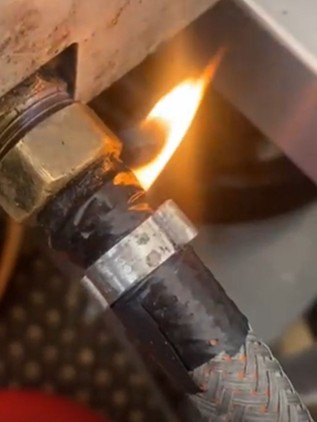
An example of a gas leak on a fitting that has become ignited. Ultimately the gas should only be burnt at the burner on the appliance and nowhere else. This is a fire hazard and could also have a catastrophic consequence should the flame arrest up the hose to the cylinder.
What to do in an LPG emergency – Gas Leak!
If you suspect a gas leak it is vital that you act quickly and calmly and observe these steps.
Typical examples of Emergency Control Valves (ECVs)
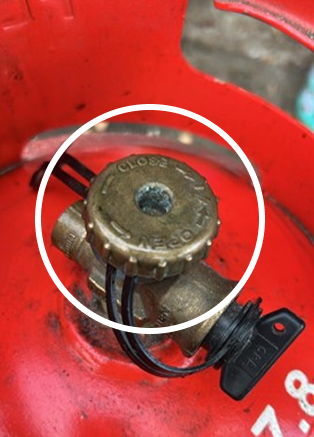
Daisy wheel on a cylinder – to isolate the supply to a single cylinder supply.
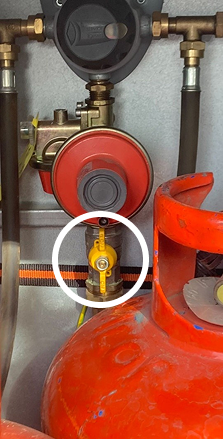
Butterfly valve incorporated as an ECV

Lever valve by a mains gas meter -to isolate the supply at its entrance point into the property

Lever valve at the entrance/exit to the catering area– referred to as an Additional Emergency Control Valve (AECV), to isolate the whole gas supply in an emergency
Gas Emergency Contact Key
These are the gas emergency contacts as outlined on the Gas Safe Register website. It’s important to know where to find these details, but hopefully you will not ever need to use them.

Here are the contact details for the main energy suppliers
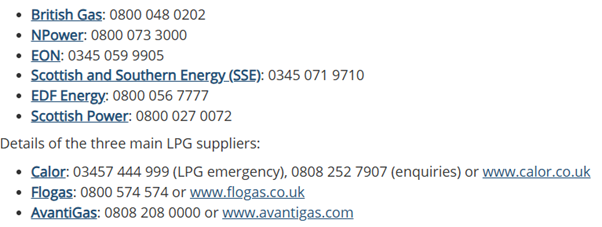
What to do in an LPG emergency – Vehicle/Unit fire!
If the vehicle or trailer carrying LPG is involved in an incident that results in a fire (e.g. because of a traffic collision) the following action should be taken.
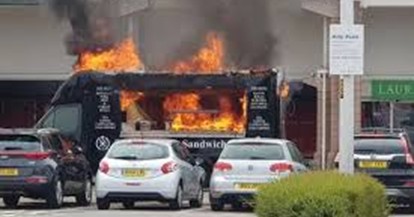
A catering vehicle on fire
What to do in an LPG emergency – Carbon Monoxide Poisoning!
You cannot see, smell, or taste the poisonous gas, Carbon Monoxide (CO). It can cause serious harm if inhaled over a period of time and in extreme cases it can cause paralysis, brain damage and even death.
We recommend you are familiar with the symptoms of carbon monoxide poisoning which include:
The symptoms can be confused with symptoms of the flu, and they can come and go, get worse while in the affected area and then get better once leaving the area.
If you suspect that you are experiencing symptoms of CO poisoning, then immediately:
Don’t take risks with your health. Protect yourself and your staff.
DO NOT TURN THE GAS BACK ON! Ensure you contact a Gas Safe Registered engineer to fully inspect and check the entire installation and have any required work completed before you use the installation/appliance(s) again.
Find your nearest Gas Engineer Partner (GEP) – tried and trusted engineers competent in LPG. Log into the members only gas engineer page.
Domestic natural gas engineers can also be found on the Gas Safe Register. Gas Safe Register – The Official List of Gas Safe Registered Businesses
Careful and proper management of LPG is key to preventing a fire. However, fires can occur because of other hazards which could then compromise the safety of the LPG. Appropriate fire precautions will vary depending on the business, its set up and its activities. However, they are likely to include:
An emergency plan is needed to make sure that people working in or using a business will know what to do if a fire occurs. It will ensure that people can be safely evacuated.
Procedures should be in place to contact the fire and rescue service without delay and to ensure that the area is evacuated immediately.
Suitable and sufficient firefighting equipment should be in place for extinguishing fires in nearby materials. Make sure everyone in the business knows how to use the fire extinguishers and fire blanket.
Firefighting equipment should be in the vicinity of all areas in which LPG cylinders and appliances are stored and used. However, fires directly involving an LPG cylinder should not be tackled with a fire extinguisher!
NCASS have prepared specific fire safety risk assessment templates to support the safe use of LPG which are available on the NCASS member dashboard.
The following NCASS Fire Risk assessment templates are available depending on the business set up:
As well as the overarching Health & Safety risk assessment template:
Ensure the business has appropriately assessed the risks of fire including the arrangements for the safe use of LPG.
e.g., using commercial grade appliances with conformity marking (e.g., CE/UKCA).
e.g., cylinders that are checked for leaks and are in good condition, free of dents and gouges.
e.g., taking into consideration the minimum distances; 1m horizontally and 0.3m vertically between cylinders and an ignitable source and anything that could become an ignitable source including combustible materials, litter and vegetation.
e.g., 2m horizontally from an unstrapped drain, rain gulleys, sunken ground and basements (never store or use below ground).
e.g., securing cylinders from toppling and protecting them from unauthorized tampering.
e.g., in a gazebo set up connecting cylinders to appliances with suitable metallic over braided or PVC wrapped flexible hoses and double eared clips.
e.g., ensuring the correct sizing of cylinders to appliances to make sure the gas supply is adequate for the appliance and to prevent incomplete combustion.
e.g., in a gazebo set up ensuring adequate ventilation from openings, removal of side panels as applicable.
e.g., in a vehicle or trailer ensuring there is a suitable mechanical extraction system interlocked to the gas supply where required.
e.g., maintaining the minimum purpose provided permanent natural ventilation in an enclosed space.
e.g., ensuring the safe suitable storage and containment of waste, combustible materials, and flammable fuels, so as not to become an ignitable source.
e.g., maintaining individual isolation valves for appliances to shut down the gas supply in the event of a leak.
e.g., maintaining an Emergency Control Valve (ECV) to shut down the entire gas supply quickly in the event of an emergency.
e.g., having designated smoking areas for staff far away from LPG supplies.
e.g., having clear “No Smoking” signage in place to alert members of the public to the presence of LPG.
The free guides and articles on the NCASS Gas Hub website will further support your business with understanding and implementing these key requirements.
If in doubt, please give us a call at NCASS.
NCASS A Quick Guide to LPG Appliances
On & Off Procedures: Gazebos, Tents or Marquees
On & Off Procedures: Vehicles and Trailers